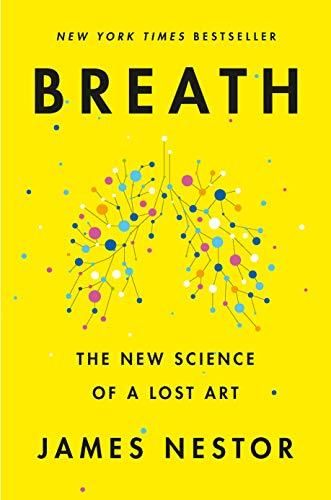James Nestor offers revelatory insights into the health and psychological benefits of breathing more slowly – and always through your nose.

Through Your Nose
A lifetime struggle with respiratory problems led James Nestor to the science and art of breathing. He discusses myriad breathing methods and myriad cultures whose ideas on breathing align. Nestor argues against mouthbreathing and the modern diet. His conclusions – most of which emerge from Nestor experimenting on himself – may surprise you and likely change your breathing habits.
Mouthbreathing
Dr. Jayakar Nayak is a nasal and sinus surgeon at the Stanford Department of Otolaryngology – Head and Neck Surgery. James Nestor, who suffered dental and respiratory problems his entire life, participated in one of Nayak’s experiments. Nestor spent a miserable 250,000 breaths with his nose plugged over 10 days of forced mouthbreathing – the experiment’s Phase I. During Phase II, Nestor breathed through his nose, practicing breathing techniques.
Inhaling air through the mouth decreases pressure, which causes the soft tissues in the back of the mouth to become loose and flex inward, creating less space and making breathing more difficult. James Nestor
Nayak and his team measured Nestor’s blood gases, inflammatory markers, hormone levels, and more. Breathing through his nose provided measurable health benefits.
George Catlin
Western civilization didn’t catch on to the power of nasal breathing until the 19th century. Renowned artist George Catlin spent six years traveling in the west and painted more than 50 Native American tribes across the Great Plains. Catlin noticed that Plains Natives had straight teeth and suffered scant chronic illnesses. They said breath was the secret to a healthy life, and that breathing through the mouth caused stress, disease, disfigured the face and decreased strength.
Catlin lived with indigenous peoples in the Andes, Argentina and Brazil. They shared breathing practices with the Plains Natives. In 1862, Catlin published The Breath of Life. Catlin had suffered lifelong respiratory problems, but began nasal breathing and lived to 76, about twice the average life expectancy of his era.
Inhale, Exhale
From ages 30 to 50, lungs lose about 12% of their capacity. Women lose more capacity than men lose. In the 1980s, researchers of the Framingham Study, a 70-year longitudinal study measuring heart disease, tested whether lung capacity correlated with longevity. After examining 20 years of data from 5,200 test subjects, the researchers noted that the most potent indicator of a longer life isn’t genetics, diet or daily exercise. It’s lung capacity.
In 1968, the respiratory researcher Carl Stough went on to work with collegiate and professional athletes. With his help, the 1968 United States Men’s track team won 12 Olympic medals, mostly gold, and set five world records.
Slower, Longer Exhales
To reap the benefits of a longer, healthier life, breathe less with fewer inhales and exhales. Breathing is similar to fasting. Regularly starving yourself of air is as bad as starving yourself of food. But training your body to breathe a lot less can lead to euphoria.
The optimum breathing rate is about 5.5 breaths per minute. That’s 5.5-second inhales and 5.5-second exhales. This is the perfect breath.James Nestor
Slower, longer exhales will boost carbon dioxide and increase aerobic endurance. Taking fewer breaths increases your VO2 max.
Soft, Processed Food
Less chewing causes breathing issues. Faces and mouths grew smaller as humans evolved. Modern humans eat mostly processed foods: white flour, white rice, jams, sweetened juices, canned vegetables and processed meats. Researchers theorize that the Industrial Age’s processed food led to smaller mouths and more difficult breathing because humans weren’t chewing as much as their primitive ancestors chewed.
Dental disease became rampant, and the incidence of crooked teeth and jaws increased tenfold in the Industrial Age. Our mouths got so bad, so overcrowded, that it became common to have teeth removed altogether.James Nestor
Starting in the 1930s, Dr. Weston Price, who founded the National Dental Association, traveled around the world comparing the teeth, airways and overall health of indigenous populations still consuming traditional food to people eating a modern diet. Price published his 500-page opus, Nutrition and Physical Degeneration, in 1939. Regardless of their diet, he found, native populations had 1.5 to 50 times more vitamins in their diet than those eating modern food.
Breathing+
Breathing+ can deepen understanding of breathing, but also cause heavy sweating, nausea and exhaustion. Breathing affects the autonomic nervous system, which divides into the sympathetic and parasympathetic nervous systems. The sympathetic nervous system responds to threats or perceived threats, causing increased heart rate and respiration, expanded pupils, blood flow redirected to muscles, etc. The parasympathetic system slows everything down – decreasing breathing and heart rate, digestion, elimination – and releases happy hormones like serotonin and oxytocin, and others.
Certain ancient cultures figured out how to manipulate the sympathetic and parasympathetic nervous systems through their breathing. For example, Tibetan Buddhists practiced Tummo – Inner Fire Meditation – for thousands of years in the Himalayas to keep themselves warm.
Tummo heated the body and opened up the brain’s pharmacy, flooding the bloodstream with self-produced opioids, dopamine and serotonin. All that, with just a few hundred quick and heavy breaths.James Nestor
Tummo is an extreme technique you should not perform while walking or driving. Pregnant women and those with heart conditions shouldn’t attempt Tummo, either. Other ancient Breathing+ techniques being revitalized include Pranayama, Adhama, Madhyama, Uttama, Kêvala, Embryonic Breath and Harmonizing Breath.
These varied breathing techniques help people expand their lungs, straighten their spines, increase circulation, achieve mind-body balance, sleep better and possibly run, swim, bike or move faster than before. However, breath work isn’t a cure-all. Breathing slowly, quickly or not at all won’t cure diseases or medical conditions, but breathing differently may help alleviate minor aches and pains.
Nasal Advocacy
Nestor has one message to offer, and finds multiple examples, including the results of experiments on himself, to support that message: Breathe through your nose, and slowly. No, more slowly than that. Unless you are a devout meditator, yogini or hard-core athlete, you most likely won’t need to read every page of Nestor’s impassioned manual. But those fascinated by the potential of the human body or dedicated to self-improvement – physical, spiritual or psychological – will find inspiration here.
James Nestor also wrote Deep: Freediving, Renegade Science and What the Ocean Tells Us About Ourselves.





